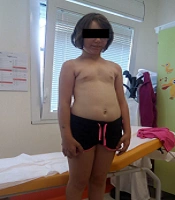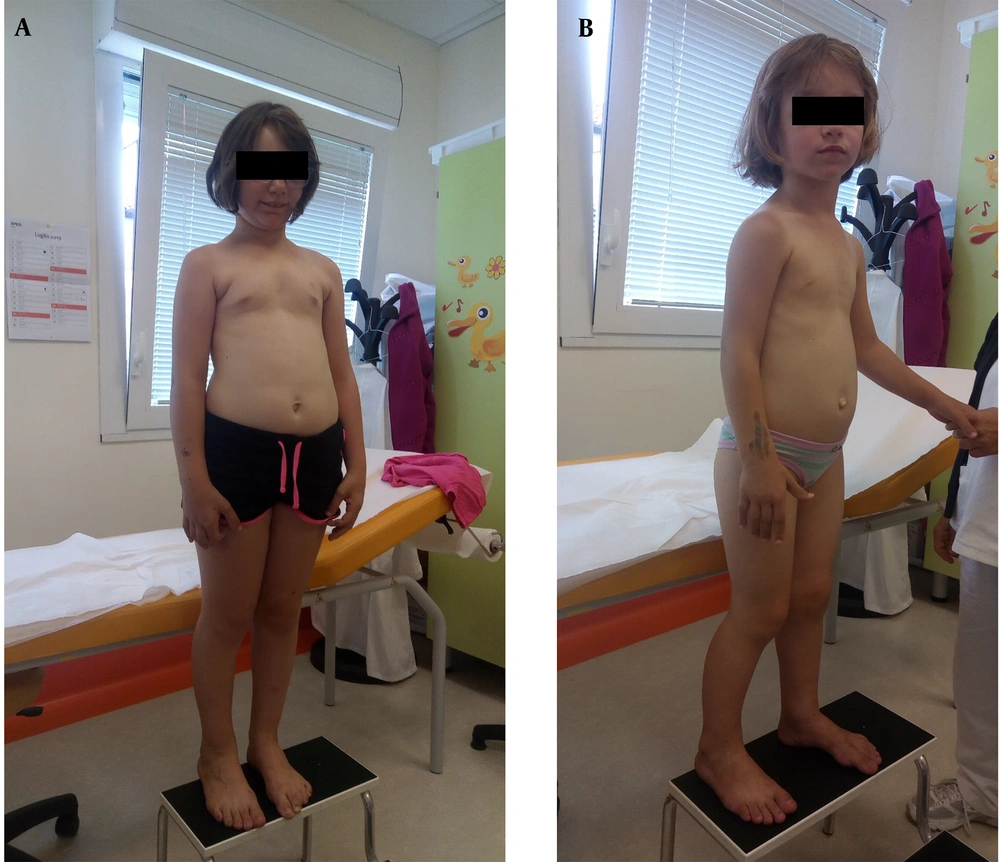1. Introduction
Tall stature is typically defined as length or height more than two standard deviations (SD) above the mean for age of the reference population. A child can also be defined tall in relation to his/her mid-parental height, if his/her height is more than two SD above the mid-parental height (1, 2).
Often tall stature is a normal variant of familiar origin, usually evident by four years of age (1). It comprises non-syndromic tall children with normal growth rate in accordance with their mid-parental height, without pubertal disorders. Despite most cases of tall stature that simply depend on the family conditions, a tall child needs to be carefully evaluated because tall stature can also be a feature of diseases associated with growth disorder, such as endocrine disorder and/or syndromic conditions like overgrowth syndromes (1).
Endocrine causes include GH/IGF-1 excess, generally caused by pituitary macroadenomas (3), or a precocious exposure to sex steroids as in precocious puberty or virilizing disorders. Tall stature can also be the result of a prolonged growth due to delayed fusion of growth plate, as it is seen in hypogonadism, aromatase deficiency, and estrogen resistance (3). Other endocrine causes can be hyperthyroidism, obesity, and constitutional advance of growth (1, 3).
Syndromic conditions can be arranged depending on the presence of proportionate/disproportionate tall stature (1, 2). The former includes generalized overgrowth syndromes (excessive growth of the whole body) such as Sotos syndrome, Malan syndrome, Weaver syndrome, and Simpson-Golabi-Behmel syndrome. Moreover, other syndromic disorders, like Fragile X syndrome, can cause a proportionate tall stature. The latter comprises segmental overgrowth syndromes, characterized by an excessive growth of one or several parts of the body (among them Beckwith-Wiedemann syndrome, Proteus syndrome, and Perlman Syndrome). Marfan syndrome, Homocystinuria, Klinefelter syndrome, and Triple X syndrome are conditions characterized by disproportionate tall stature not associated to overgrowth (1). All these conditions are usually due to a particular monogenic disorder or a peculiar genetic alteration.
2. Case Presentation
A 20-month-old girl came to our Pediatric Endocrinology Centre for tall stature and overgrowth. Parents were not related, and no noteworthy diseases were reported in her family history, particularly no cases of tall stature. Her mid-parental height was 164 cm. No problems were reported during pregnancy, and fetal ultrasounds were normal. The cytogenetic analysis on the chorionic villus sampling showed a 46 XX karyotype. She was born at term by vaginal delivery without complications. Birth weight was 3,730 g (0.96 SD), birth length was 56 cm (3.67 SD), and birth head circumference was 35.5 cm (1.06 SD). The perinatal period was normal with regular discharge. No episode suggestive of hypoglycemia was mentioned. A slight neurodevelopmental delay was reported, with a minor delay in the speech development.
At our first physical examination, her height was 96.5 cm (5.25 SD), weight was 15.7 kg (3 SD), and head circumference was 52 cm (3.92 SD). Growth velocity was 16.4 cm/year. We observed large extremities in the absence of macroglossia and asymmetries. No signs of puberty were detected. According to Greulich and Pyle, bone age was extremely advanced (5 years) compared to the chronological age. Thyroid function, serum IGF-1, and prolactin were within normal range, and no alteration of glycaemia and blood insulin levels were detected. Sotos syndrome was clinically suspected, and the research of alterations in NSD1 gene was performed. The analysis was normal and Sotos syndrome was ruled out.
Although a clinical follow- up was strongly suggested, she did not come to the hospital for a long period. At the following evaluation, she was seven years and 10 months old. Her height was 144.5 cm (2.92 SD), weight was 41 kg (1.76 SD), and body mass index (BMI) was 19.6 kg/m2 (1 SD). A broad forehead with backward hairline was noticed at the physical evaluation. She came with her 3-year-and-8-month old sister, who had a similar clinical presentation. She was born at term by vaginal delivery without complications (birth weight: 3600 g, SD: 0.68; head circumference: 34 cm, SD: 0.08). No episodes suggestive of hypoglycemia were reported. She also presented a slight neurodevelopmental delay (first steps at 17 months and first words at 18 months). At the physical examination, her height was 116.5 cm (3.41 SD), weight was 20.5 kg (1.49 SD), and BMI was 15.1 kg/m2 (-0.32 SD). We noticed large extremities, broad forehead, epicanthus, and a triangular face. No macroglossia, asymmetries of the body, or signs of puberty were detected (Figure 1). Like her sister, all laboratory tests resulted within normal range.
According to the clinical signs and the similar phenotype of her sister, the suspect of an overgrowth syndrome was high and the girl was submitted to the molecular analysis of seven selected genes involved in overgrowth syndromes (DNMT3A, EZH2, GPC3, GPC4, NFIX, NSD1, and PTEN). To identify causative mutation in these genes, the genomic DNA was extracted from peripheral blood leukocytes, and targeted next generation sequencing (NGS) was performed. The pathogenic mutation c.2050C > T p.(Arg684Cys) in EZH2 gene was isolated in our patient. It was in heterozygosity, and it allowed the diagnosis of Weaver syndrome. The parents did not want to proceed with genetic analysis in the sister.
The study was conducted in compliance with the terms of the Helsinki II Declaration. Written informed consent was obtained from the patient’s parents for publication of this case report. In Italy, this type of clinical study does not require Institutional Review Board/Institutional Ethics Committee approval to publish the results.
3. Discussion
Weaver syndrome is a rare clinical condition characterized by prenatal and postnatal generalized overgrowth with accelerated bone maturation. The phenotypic spectrum of Weaver syndrome is extremely wide. The clinical features are a distinctive craniofacial appearance with macrocephaly, broad forehead, hypertelorism, almond-shaped palpebral fissures, flattened occiput, large ears, prominent wide philtruml, and relative micrognathia; camptodactyly of the fingers and/or toes; thin, deep-set nails and soft, doughy skin with redundant nuchal skin folds (4-6). The characteristic facial appearance is most distinctive at a younger age, and it evolves over time (7, 8). Generally, patients do not perfectly match the phenotype. As a matter of fact, our patient showed only some of the above-mentioned features. In addition to tall stature and an extremely advanced bone age, she had a broad forehead but did not present other facial characteristics. She had large extremities, but no camptodactyly or nail alterations were detected.
Moreover, afflicted individuals may have umbilical hernia, congenital heart defects, and brain anomalies, such as cysts of septum pellucidum, central atrophy, and pachygyria (4). Central hypotonia, poor coordination, and motor development delays are also common; lastly some infants have a hoarse low cry (9). Intellectual disabilities ranging from mild to severe have been described, involving particularly verbal expression (7, 8). According to this data, a slight neurodevelopmental delay involving verbal expression was detected in our patient and in her sister.
The presence of tall stature, associated with the above-mentioned dysmorphic features, a developmental delay, and with a sister with similar syndromic features led us to the hypothesis of an overgrowth syndrome. The normal results of laboratory tests had already ruled out endocrine causes. Since our case showed no asymmetries or other sign of a disproportionate tall stature, the first suspect was Sotos syndrome, also characterized by tall stature as main clinical sign. Sotos patients have birth length above 2 SD, and their height continues above 2 SD until puberty (3), with an overgrowth of the whole body causing a proportionate tall stature. Most patients also have an advanced bone age. Macrocephaly is often present since birth, and it is associated with a broad range of learning disabilities, particularly delays in motor development and expressive language. Typical Sotos facial features include frontal bossing, dolichocephaly, down-slanting palpebral fissures, and frontoparietal receding hairline. Anomalies in cranial imaging can be detected, like dilatation of the cerebral ventricles; cardiac and renal abnormalities may also occur (4).
Our patient showed phenotypical features belonging to both Sotos and Weaver syndromes, such as tall stature, advanced bone age, a broad forehead with backward hairline, and a slight neurodevelopmental delay with no exclusive characteristic of one syndrome. Although in Weaver syndrome there is a facial appearance that experts find convincingly different from that of Sotos individuals, Sotos and Weaver syndromes are paradigmatic of the daily difficulties faced by clinical geneticists attempting to diagnose in cases of extensive phenotypic overlap (10). As consequence, several authors had proposed that Sotos and Weaver syndromes could be allelic diseases (10). As a matter of fact, due to the wide phenotypic spectrum and the clinical overlap between them, the differential diagnosis of overgrowth syndromes can be challenging. A substantial help is provided by molecular biology, and particularly by genetic analysis with NGS approach. In fact, these two syndromes have a different genetic basis. Specifically, Sotos syndrome is caused by haploinsufficiency of NSD1 gene (3), while the diagnosis of Weaver syndrome is established through the identification of a heterozygous EZH2 pathogenic variant on molecular testing (7, 11), as we detected in our patient. EZH2 gene encodes for a SET domain-containing histone methyltransferase, which is associated with transcriptional repression through epigenetics. Nevertheless, the pathogenic mechanism implicated in Weaver syndrome is not well known yet (4). Somatic disruption of EZH2 is important in the development of many tumors, particularly hematopoietic malignancies; this suggests a greater risk of cancer in individuals with Weaver syndrome. Approximately 5% of the patients develop tumors, such as lymphoma, acute lymphoblastic leukemia, neuroblastoma, and sacrococcygeal teratoma (4, 6). An increased risk of developing cancer has been reported in children affected by overgrowth syndromes, since the genetic or epigenetic disorders involved in these conditions have also been observed in several tumors (9, 12). A specific protocol for cancer surveillance has been validated only for some of these syndromes, and there is not a shared guideline for Weaver syndrome. Nevertheless, a follow-up is strongly suggested for these patients with the aim of an early diagnosis of cancer and consequently a prompt treatment.
In conclusion, tall children can be a big challenge for the pediatric endocrinologist, who firstly has to rule out the main hormonal disorders that can affect growth. Although most tall children have a familial trait or a transient anticipation of growth with no major consequences, it is extremely important not to forget the differential diagnoses, particularly those associated with greater risks of cancer like overgrowth syndromes. A syndromic condition, as the Weaver syndrome in our case, has to be suspected when the tall stature is associated with dysmorphic features as a typical facies, malformations, and neurodevelopmental delay. In these circumstances, molecular biology, particularly NGS, helps in reaching a final diagnosis, and consequently in establishing the most appropriate treatment and follow-up.
Finally, it is imperative report that in overgrowth patients “big” is not the synonym of “strong” or “brawny”, but rather of “fragile” given the uncertain prognosis due to the increased risk of cancer, and the social distress that can originate from the more or less severe intellectual disabilities and from physical difference from peers.

